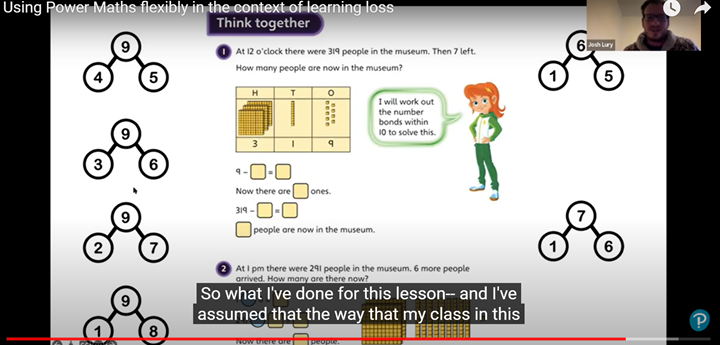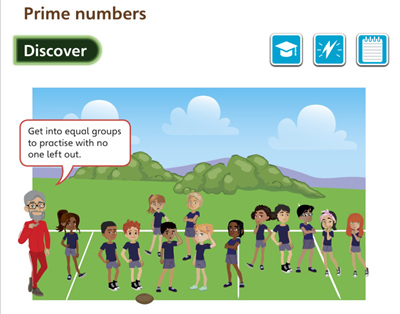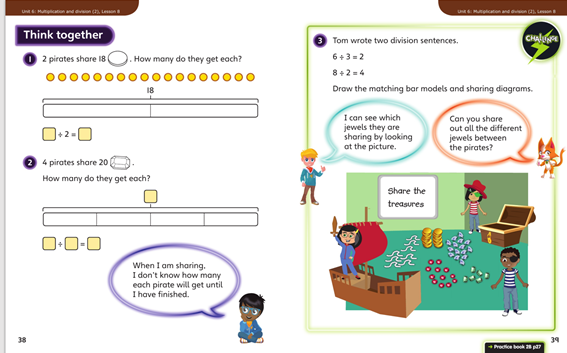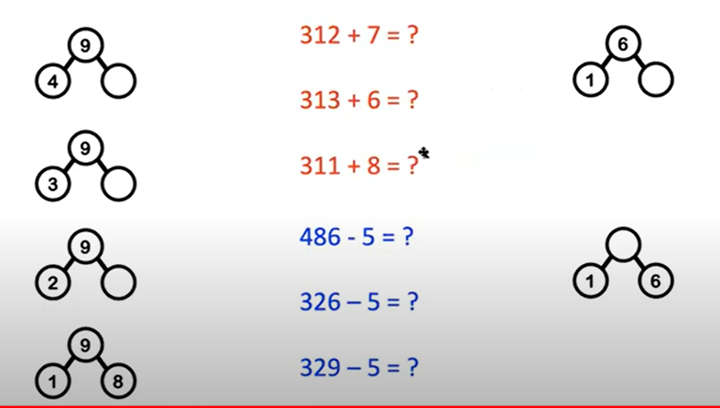
In January 2022, we held a webinar to share advice from our authors, Tony Staneff and Josh Lury, about how to use Power Maths flexibly in response to lost learning created by the pandemic. Many children are not going into each new unit at the usual, expected starting point, and the volume of missed learning is variable. Please watch the webinar if you have time (it’s 1 hour). Otherwise, this blog is designed to sum up some key points.
The structure and consistency of the Power Maths programme will be more valuable than ever in supporting children to master the key content in each year group, if used a bit more flexibly. Teachers will need to consider which of the suggestions below are appropriate for their class – some may be necessary while others won’t. There should still be a significant workload benefit in using the resources, once you get used to what works best for your class.
1. Use the guidance that’s already there
If you haven’t already, take a look at the articles on our ongoing support page. The articles for children working below expectation, on depth and challenge, and KS1 should be especially useful in the context of learning loss, including lots of practical ideas for tweaking the Power Maths materials.
You can also scroll past the blogs and the webinars and take a look at the ‘Advice for 2021-22′ part of the ongoing support page. There is advice here on many topics, including: choosing what topics to cover, identifying and addressing gaps in learning, building up children’s fluency, and managing a class with a wide attainment spread. There are some additional thoughts on these below, but it would be worth looking through the FAQs if you haven’t already.
2. Deciding what to cover
Many teachers will be using the matching to the NCETM’s ‘Ready to Progress’ criteria (on the Planning Guidance* page). This is a way of identifying the most essential content, either to spend more time on these or to omit other topics.
Another thing to be aware of is that some lessons in Power Maths (especially KS1) cover the non-statutory guidance that appears underneath the statutory objectives in the Programme of Study. You might decide to leave these lessons out for the time being (see the list in the Appendix below) or do so on a case-by-case basis.
Remember that the Power Maths progression gives flexibility about how long you spend on each topic, so that children master the key learning before moving on. Whatever you decide to cover, try not to rush. You don’t have to do a lesson in one day. Equally, you don’t have to complete every part of a lesson if you feel you’ve covered the essential learning really well, and children aren’t ready for that last small step (e.g. the Challenge question).
* Note: for this link to work you will need to already be logged into ActiveLearn.
3. Pre-teaching and starter activities
Would some children in the class benefit from pre-teaching? There are some tips for this in the blog for children working below expectation.
In the current scenario, you may want to think carefully about your lesson starters. The Power Ups provide general number fluency practice throughout the year, allowing you to keep all topics bubbling away. If you are worried your class has missed out on prior learning, or lacks the requisite fluency for the lesson in question, you may want to do a quick starter on prior learning or relevant number skills instead. E.g. for Y5 negative numbers you might use a few recap questions from Y4, or you might opt to quickly practise number bonds to 10 for a lesson on 2-digit addition. This might just apply to some lessons and depends on your class, but if there are any Power Ups you don’t use, you can always use them for extra fluency practice outside the main lesson.
4. Managing a wider-than-ever spread of attainment (differentiation)
There are some good ideas for this towards the end of the webinar. For the lesson you are teaching, what is the ‘golden nugget’ at the heart of the lesson that you want children to take away, if you boil it down to just one sentence? What is it that could get in the way of children coming away with that golden nugget?
Often it will come down to basic number fluency. Besides pre-teaching, you can support this by providing the range of number facts they will need for answering the questions in the lesson (you could put them on the board or around the room).
In the webinar images below, see how Josh has arranged supportive number facts, using part-whole models, to go with the questions on the page. Children still have to do the thinking: which fact do I need for this question? But they aren’t prevented from accessing the lesson. (Note that you could also decide to block out some numbers in the part-whole models as Josh has in the second image below.)
The consideration for the teacher is, how much do you want the children concentrating on churning the numbers, and how much do you want them focusing on decisions about methods etc? This will vary from lesson to lesson.
At the same time you may be trying to cater for those who are ready to go into greater depth. Josh shows how you can go back to the ‘Discover’ (or it could be another section) and make up some extra, challenging questions based on the core idea of the lesson. In the example below, the context is people coming in and out of the museum, and the extra questions are long calculations.
Notice that these questions are posed in the abstract (something the children are ready for in this example). You could follow up with the children by asking what strategies they used for long strings of numbers. Maybe they found it easier to deal with the small numbers first.
5. Tips for ‘Discover’
In a word, ‘Discover’ is about curiosity. Think of the picture as an invitation to be creative in order to stimulate children’s curiosity. If it’s a picture of a rocket (Y1 Counting down from 10), can you find or borrow a ‘stomp rocket’ to set off each time children count down to zero? If it shows children in the playground, could you do the activity in the playground (e.g. sorting themselves into equal groups)? Does the picture give you a chance to play a game, or dress up, or tell a story? Or could you tweak the context easily to fit with something your class are interested in? Hopefully thinking about this is time well spent, as well as being fun, because it makes the lesson memorable. We suggest children work in pairs on the questions, giving everyone a chance to have a go, collaborate and share ideas.
Using ‘Discover’ flexibly: There are two questions on the Discover page, which gives you a chance to consolidate and make sure all children are comfortable with the ideas introduced. If the children get it after the first one, and you feel as the teacher that there is more to be gained by moving on, there’s no obligation to do both.
6. Tips for ‘Share’
The ‘Share’ section is about bringing the meaning to life. These pages offer lots of representations to explain what’s going on with the maths, as a variety of representations is recommended by NCETM. This allows you to show more than one way to solve a problem and allows you to compare methods, which creates an opportunity to deepen children’s understanding. Children can also compare their methods with those of the Power Maths characters.
Using ‘Share’ flexibly: Given children’s starting points, you may decide it would be better to focus on just one of the representations to keep things a bit simpler. As per Tony’s advice in the webinar, the vital thing during the ‘Share’ section is for the teacher to link up the Concrete, Pictorial and Abstract representations.
7. Tips for ‘Think Together’
This section is for children to think carefully about the maths. If you look through the questions, consider how the scaffolding is gradually removed. For example, in the example below: Q1 shows 18 individual jewels and gives some of the numbers in the pictorial and abstract representations; Q2 takes away the numbers etc but gives the layout; in Q3 children have to lay it out themselves.
Using ‘Think Together’ flexibly: The questions in the book provide a sequence that helps children to take a small step forward each time, and as a teacher it’s interesting to ask (yourself or the children) what’s the same and what’s different each time. However, you may decide as the teacher that children need a bit more consolidation to be able to take each of these small steps. For example, if you’re doing formal methods, you might just want to do a few ‘more of the same’ examples. In the webinar, Josh gave an example of some extra ‘Think Together’ questions for the lesson he was looking at (see image below), which could be generated very quickly and easily.
You can allow children to focus just on the question, and not worry so much about the scaffolded answer boxes, if you feel that would be helpful (for instance, if they are using a different method). And you may also feel you want to build confidence steadily and not take on the challenge question if children are finding it difficult. (The challenge question is designed to be accessible to all children who have worked through the preceding steps, i.e. it’s not a specifically ‘high-ability’ task, but that doesn’t mean every child has to do it.) In the ‘Think Together’ section, it’s vital that it’s the children doing the thinking, not the teacher.
8. Other tips for using Power Maths flexibly
Change does take time, so if you’re completely new to Power Maths, don’t worry too much if you’re still trying to get the hang of some elements. It might be a good idea to focus on really embedding one part at a time. That could be an extra focus on each part of the lesson (‘Discover’, ‘Share’ etc) and how you could enhance your delivery of these, one at a time, through the school. Or you could do it by component, working on how to get the most out of the different resources one-by-one.
The effects of learning loss will, of course, present an extra challenge, but hopefully the extra preparation shouldn’t be too extensive. As you plan each lesson, think about what’s coming up next and about the stage your group is at, and whether you might use any of the ideas above (e.g. supporting fluency or adding a few extra questions). Once you’ve decided on your general approach to covering the content (see part 2), that should make everything a bit easier.
Tony talked in the webinar about reading level and doing the reasoning questions together if you have to. Bear in mind that some of the reading challenge comes from specific maths vocabulary, which children will need to learn. Could you spend some time focusing on maths keywords that would help children interpret the reasoning questions more independently?
Finally, we would recommend spending extra time on number fluency outside the lesson. Can you fit in a short afternoon ‘maths meeting’ or use time at the start of the day to practise number bonds and times tables etc? It is also a chance to use a Power Up you haven’t used already.
In summary
There are lots of ways of using the Power Maths materials flexibly to make it effective in the context of learning loss. Each class will be different, so it will vary as to which of the ideas above you use the most, but you should be able to make tweaks here and there without any significant increase in your planning time. Don’t forget to look back at the blogs and guidance that are already available (see 1.).
We’d love to hear your ideas and find out about what has worked best in your class! Email us at ukschools.customersuccess@pearson.com.
Sign up to receive our blog updates
Like what you read and want to receive more articles like this direct to your inbox? Subscribe to our blog and we’ll send you a fortnightly digest of the blog posts you may have missed, plus links to free resources to support your teaching and learning.










